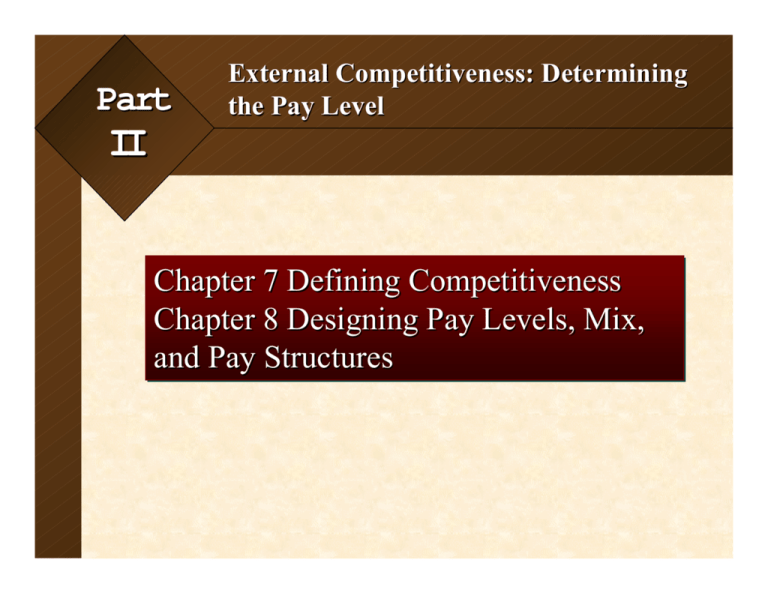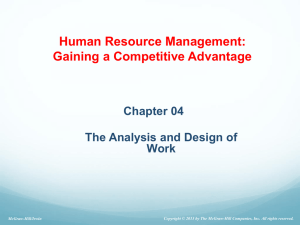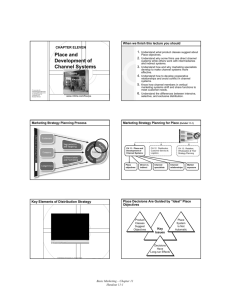
7-1
Part
External Competitiveness: Determining
the Pay Level
II
Chapter 7 Defining Competitiveness
Chapter 8 Designing Pay Levels, Mix,
and Pay Structures
McGraw-Hill/Irwin
© 2002 by The McGraw-Hill Companies, Inc. All rights reserved.
7-2
STRATEGIC
POLICIES
ALIGNMENT
COMPETITIVENESS
CONTRIBUTORS
STRATEGIC
OBJECTIVES
TECHNIQUES
Work
Descriptions
Analysis
Market
Surveys
Definitions
Seniority
Based
Evaluation/
Certification
Policy
Lines
Performance
Based
Merit
Guidelines
INTERNAL
STRUCTURE
PAY
STRUCTURE
INCENTIVE
PROGRAMS
EFFICIENCY
• Performance
• Quality
• Customers
• Stockholders
• Costs
FAIRNESS
COMPLIANCE
ADMINISTRATION
Planning Budgeting Communication EVALUATION
McGraw-Hill/Irwin
© 2002 by The McGraw-Hill Companies, Inc. All rights reserved.
7-3
Chapter
7
Defining Competitiveness
McGraw-Hill/Irwin
© 2002 by The McGraw-Hill Companies, Inc. All rights reserved.
7-4
Learning Objectives
After studying Chapter 7, students should be able to:
1.
2.
3.
4.
Explain the importance of external
competitiveness to the pay model.
Discuss the factors that influence external
competitiveness.
Discuss the difference between labor market,
product market, and organizational factors in
determining external competitiveness.
Explain the different pay policy decisions and
the consequences of using each.
McGraw-Hill/Irwin
© 2002 by The McGraw-Hill Companies, Inc. All rights reserved.
7-5
External competitiveness
refers to the pay relationships
among organizations - the
organization’s pay relative to its
competitors.
McGraw-Hill/Irwin
© 2002 by The McGraw-Hill Companies, Inc. All rights reserved.
7-6
External competitiveness is expressed in
practice by:
setting a pay level that is above,
below, or equal to competitors, and
2. by considering the mix of pay forms
relative to those of competitors.
1.
McGraw-Hill/Irwin
© 2002 by The McGraw-Hill Companies, Inc. All rights reserved.
7-7
Pay level refers to the average of the array of
rates paid by an employer.
Σ Base + Bonuses + Benefits + Options / Σ Employees
Pay forms refer to the mix of the various types of
payments that make up total compensation.
McGraw-Hill/Irwin
© 2002 by The McGraw-Hill Companies, Inc. All rights reserved.
7-8
Pay level and mix focus attention
on two objectives:
Control Labor Costs
Attract and Retain
Employees
McGraw-Hill/Irwin
© 2002 by The McGraw-Hill Companies, Inc. All rights reserved.
7-9
Pay Level Decisions Impact Labor Costs
Labor Costs
McGraw-Hill/Irwin
=
Number of
Employees
x
Pay Level
© 2002 by The McGraw-Hill Companies, Inc. All rights reserved.
7 - 10
What Shapes External Competitiveness?
LABOR
LABOR MARKET
MARKET FACTORS
FACTORS
Nature
Nature of
of Demand
Demand
Nature
Nature of
of Supply
Supply
PRODUCT
PRODUCT MARKET
MARKET FACTORS
FACTORS
Degree
Degree of
of Competition
Competition
Level
Level of
of Product
Product Demand
Demand
EXTERNAL
EXTERNAL
COMPETITIVENESS
COMPETITIVENESS
ORGANIZATION
ORGANIZATION FACTORS
FACTORS
Industry,
Industry, Strategy,
Strategy, Size
Size
Individual
Individual Manager
Manager
McGraw-Hill/Irwin
© 2002 by The McGraw-Hill Companies, Inc. All rights reserved.
7 - 11
Labor Demand
! The marginal product of labor is the additional
output associated with the employment of one
additional human resource unit, with other
production factors held constant.
! The marginal revenue of labor is the additional
revenue generated when the firm employs one
additional unit of human resources, with other
production factors held constant.
McGraw-Hill/Irwin
© 2002 by The McGraw-Hill Companies, Inc. All rights reserved.
7 - 12
Supply and Demand at the Market and Individual
Employer Level
Market level
De
ma
nd
$50,000
ply
p
Su
$25,000
Ma
rg
in
pr al r
od ev
uc en
t ue
$100,000
Pay for business graduates
Pay for business graduates
$100,000
Employer level
$50,000
Supply to
individual
employer
$25,000
0
Number of business graduates available
McGraw-Hill/Irwin
5
10
15
20
25
Number of business graduates available
© 2002 by The McGraw-Hill Companies, Inc. All rights reserved.
7 - 13
Labor Demand Theories and Implications
Theory
Compensating
differentials
Efficiency wage
Signaling
McGraw-Hill/Irwin
Prediction
So What?
Work with negative
characteristics requires higher
pay to attract workers.
Job evaluation must collect
and compensable factors
most capture these negative
characteristics.
Above-market wages will improve
efficiency by attracting workers
who will perform better and be
less willing to leave.
Staffing programs must have
the capability of selecting the
best employees. Work must
be structured to take
advantage of employees’
greater efforts.
Pay policies signal the kinds of
behavior the employer seeks.
Pay practices must recognize
these behaviors by better pay,
larger bonuses, and other
forms of compensation.
© 2002 by The McGraw-Hill Companies, Inc. All rights reserved.
7 - 14
Labor Supply Theories and Implications
Theory
Reservation wage
Human capital
Job competition
McGraw-Hill/Irwin
Prediction
So What?
Job seekers won’t accept jobs
whose pay is below a certain
wage, no matter how attractive
other job aspects.
Pay level will affect ability to
recruit.
The value of an individual’s skills Higher pay is required to
and abilities is a function of the
induce people to train for
time and expense required to
more difficult jobs.
acquire them.
Workers compete through
qualifications for jobs with
established wages.
As hiring difficulties increase,
employers should expect to
spend more to train new hires.
© 2002 by The McGraw-Hill Companies, Inc. All rights reserved.
7 - 15
Competitive Pay Policy Alternatives
Pay with Competition
(Match)
Lead Policy
Lag Policy
Flexible Policies
Employer of Choice
Shared Choice
McGraw-Hill/Irwin
© 2002 by The McGraw-Hill Companies, Inc. All rights reserved.
7 - 16
Pay Mix Policy Alternatives
Performance - Driven
Market Match
Benefits
17%
Benefits
20%
Options 4%
Options
16%
Base 50%
Base 70%
Bonus 6%
Bonus
17%
Work - Life Balance
Benefits
20%
Benefits
30%
Base 50%
Options
10%
Security (Commitment)
Base 80%
Bonus
10%
McGraw-Hill/Irwin
© 2002 by The McGraw-Hill Companies, Inc. All rights reserved.
7 - 17
Some Consequences of Pay Levels
Contain operating
expenses (labor costs)
Competitiveness of total
compensation
Reduce pay-related
work stoppages
McGraw-Hill/Irwin
Increase pool of
qualified applicants
Increase quality and
experience
Reduce voluntary
turnover
Increase probability of
union-free status
© 2002 by The McGraw-Hill Companies, Inc. All rights reserved.
7 - 18
Summary
! There is no “going rate,” thus managers make conscious
pay level and mix decisions influenced by several
factors.
! There are both product market and labor market factors
that impact the pay level and mix decisions.
! Alternative pay level and mix decisions have different
consequences.
! Pay policies need to be designed to achieve specific pay
objectives.
! To achieve the objectives stipulated for the pay system,
both the pay level and mix must be properly positioned
relative to competitors.
McGraw-Hill/Irwin
© 2002 by The McGraw-Hill Companies, Inc. All rights reserved.
7 - 19
Review Questions
1.
2.
3.
4.
Distinguish policies on external competitiveness
from policies on internal alignment. Why is
external competitiveness so important?
What factors shape an organization’s external
competitiveness?
What does marginal revenue product have to do
with pay?
What pay level does the efficiency wage theory
predict? Does the theory accurately predict
organization behavior? Why or why not?
McGraw-Hill/Irwin
© 2002 by The McGraw-Hill Companies, Inc. All rights reserved.
7 - 20
Review Questions (continued)
5.
6.
What is a relevant market? What difference does it
make when determining people’s pay?
Can you think of any companies that follow a lag
and/or lead policy? Why do they believe it pays to
pay differently? Can you think of any companies
that follow performance-driven and/or work-life
balance policies?
McGraw-Hill/Irwin
© 2002 by The McGraw-Hill Companies, Inc. All rights reserved.









